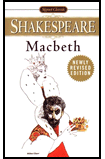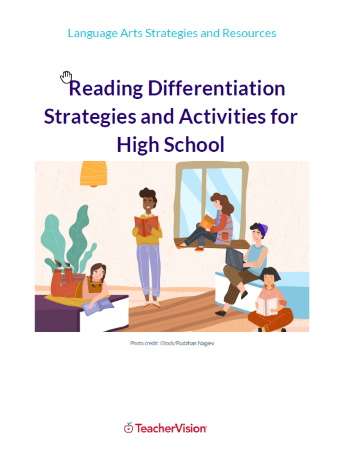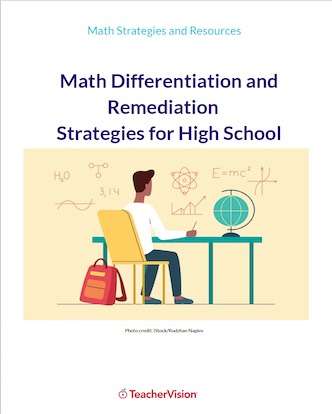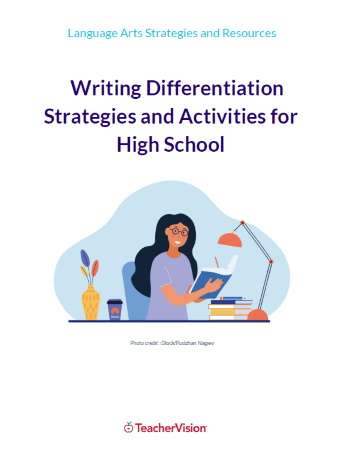Macbeth
by William Shakespeare
- Overview
- Before Reading the Play
- While Reading the Play
- After Reading the Play
- Extended Learning
- Bibliographies
- About the Guide Author
- About the Guide Editors
- Buy this Book!
Enter promo code TEACH for 15% off.
INTRODUCTION
William Shakespeare developed many stories into excellent dramatizations for the Elizabethan stage. Shakespeare knew how to entertain and involve an audience with fast-paced plots, creative imagery, and multi-faceted characters. Macbeth is an action-packed, psychological thriller that has not lost its impact in nearly four hundred years.
The politically ambitious character of Macbeth is as timely today as he was to Shakespeare's audience. Mary McCarthy says in her essay about Macbeth, "It is a troubling thought that Macbeth, of all Shakespeare's characters, should seem the most 'modern,' the only one you could transpose into contemporary battle dress or a sport shirt and slacks." (Signet Classic Macbeth)
Audiences today quickly become interested in the plot of a blindly ambitious general with a strong-willed wife who must try to cope with the guilt engendered by their murder of an innocent king in order to further their power. The elements of superstition, ghosts, and witchcraft, though more readily a part of everyday life for the Renaissance audience, remain intriguing to modern teenagers. The action-packed plot, elements of the occult, modern characterizations, and themes of import to today's world make Macbeth an excellent choice for teaching to high school students.
This study guide offers ideas for presenting Macbeth to a high school class. The activities have been divided into sections:
(1) a brief literary overview, including a synopsis and commentary on the play;
(2) suggestions for teaching the play, including ideas for incorporating it into a thematic unit, activities, discussion questions, essay topics to be used before, during, and after reading the play;
(3) ideas to extend students' learning beyond the play, including ways to address its themes, ideas for teaching literary analysis, techniques for using the play as a bridge to other works;
(4) bibliographies.
Since Macbeth is a play dealing with adult themes and emotions, it is difficult reading for many adolescents. Therefore, this study guide will focus attention on the ability levels of students, and specific activities, discussion questions, and topics will be labeled as to difficulty.
* Appropriate for all students.
+ Most appropriate for nonacademic students.
# Most appropriate for above average students.
% Most appropriate for academic students.
Act I
Three witches meet Macbeth and Banquo on the heath as the men return from battle. They predict that Macbeth will be named Thane of Cawdor and King of Scotland and that Banquo will be the father of kings. The witches vanish; Ross enters to greet Macbeth with the title of Cawdor, the traitor whom King Duncan has determined must be executed and whose title and lands will be given to Macbeth. This immediate "earnest of success commencing in a truth" causes Macbeth to consider the extent of his ambition and Banquo to warn that predictions are often harmful as well as beneficial. (iii.)
Announcing that his eldest son, Malcolm, is to be his heir, Duncan states his intention to visit Macbeth's castle, Glamis. (iv.) When Lady Macbeth reads the letter Macbeth has sent ahead, she determines her husband must take advantage of the opportunity Duncan's forthcoming visit offers as a way of fulfilling the prophecy. However, she fears that though Macbeth is "not without ambition," he is "too full o' th' milk of human kindness to catch the nearest way." (v.)
Macbeth is not as determined as his lady about the need for murder. He considers reasons he should defend rather than threaten the life of his king. Lady Macbeth remains adamant and pressures him with attacks on his manhood as well as reminders of their feelings for each other. She convinces Macbeth to proceed by presenting her plan to drug Duncan's guards and leave evidence that will implicate them in the crime. (vii.)
Act II
Macbeth sees a "dagger of the mind" leading him towards Duncan's chamber. (1.) Lady Macbeth has drugged the guards, noting that Duncan's resemblance to her father has stayed her from doing the deed herself. After the murder, Macbeth carries the bloody daggers from the chamber causing Lady Macbeth to reprimand him for his great show of emotion. After she returns the daggers and smears the guards with blood, she tells Macbeth, "a little water clears us of this deed." (ii.)
The porter attends the knocking at the gate, creating a comic relief scene of his imaginings. Macduff discovers the body, and Macbeth kills the guards, explaining the act as his overwrought response to their unjust offense. Duncan's sons realize their danger and decide that Malcolm will go to England and Donalbain will go to Ireland. (iii.) Their flight makes them suspect, and Macbeth is crowned King of Scotland. (iv.)
Act III
Macbeth plans to overturn the witches' prophecy that Banquo's sons will become kings by sending two murders to kill both Banquo and his son, Fleance. (i.) Macbeth no longer needs Lady Macbeth's involvement and bids her be "innocent of the knowledge" of his decisions. (ii.) A third murderer, obviously not known by the other two, joins them, and although Banquo is slain, Fleance escapes. (iii.)
At the banquet, Macbeth is terrified by the bloody ghost of Banquo. Since no one else sees the apparition, Lady Macbeth attempts to excuse his behavior and eventually has to end the banquet. Macbeth determines to visit the witches again. (iv.)
Suspicion of Macbeth is mounting, and Macduff joins Malcolm in England. (vi.)
Act IV
The witches show Macbeth three apparitions which warn him to beware Macduff, promise him that "none of woman born shall harm Macbeth," and assure him he will remain safe until Birnam Wood moves. He feels comforted by these prophecies without seeing their double meaning but is shaken by a vision of Banquo and his eight descendants. (I.)
Malcolm tests Macduff's loyalty to Scotland, and they plan strategy with English forces to oust Macbeth. (iii.) Meanwhile, Macbeth has Lady Macduff and all her children slain. (ii.)
Act V
Lady Macbeth, while sleepwalking, reveals her knowledge of the deaths of Duncan, Lady Macduff, and Banquo. Her continual washing of her hands cannot ease her dread or make her feel cleansed. The doctor and attendant realize they cannot help her. (i.)
Macbeth is too involved with battle preparations against Malcolm and English and Scottish troops to spend much time considering his wife's dreams. (iii.) When he hears of Lady Macbeth's death, he contemplates that life is "full of sound and fury, signifying nothing." He reassures himself with the predictions only to see the woods advance when Malcolm's soldiers camouflage themselves with boughs from Birnam Wood. (v.)
Macbeth sees the ambiguity of the predictions but goes bravely into battle. He kills young Siward who dies fearlessly (vii.) and then faces Macduff who tells him that he was not "of woman born" but was "untimely ripped" from his mother's womb. Finally realizing the true implications of the predictions, Macbeth refuses to yield to Macduff and face capture and ridicule. He confronts Macduff and bravely fights to the death. Macduff displays the "usurper's cursed head" and acclaims Malcolm the new King of Scotland. (viii.)
Commentary
Origin of the Play
William Shakespeare's talents were in the creative dramatization of a story full of imagery and imagination rather than in the origination of the story itself. For his inspiration, he often consulted Holinshed's Chronicles of England, Scotland, and Ireland.
According to the Chronicles, the "real" Macbeth became King of Scotland in 1040 after having defeated a historical Duncan who was a weak, youthful ruler with little experience. Shakespeare presents an older King Duncan who is due the respect of his thanes; consequently, his murder is more heinous in the dramatic interpretation.
In the Macbeth of Holinshed's Chronicles, the wife of Macbeth is hardly mentioned. Shakespeare develops the impressive character of an ambitious Lady Macbeth from a different story found in the Chronicles.
The historical Macbeth reigned for 17 years and survived the battles which returned Malcolm to the throne: whereas, Shakespeare presents a series of events which speed to the conclusion of a Macbeth defeated and beheaded.
King James
Shakespeare enjoyed much support for Queen Elizabeth who encouraged the artistic efforts of her subjects during the creative Renaissance years. After her death, James VI of Scotland became James I, King of England, in 1603.
Because James was considered the eighth descendent of the Banquo-Fleance line, Shakespeare "polished" the historical representation to present Banquo's character in a more honorable light. The Banquo of Holinshed's Chronicles is actually involved in the conspiracy to murder King Duncan.
James produced the book, Daemonologie (1597), which provided ways to recognize witches as well as to defeat their spells. He was particularly concerned with the threat of witchcraft after several women were tried in connection with their self-acclaimed attempt to sink his ship during his wedding journey. These women claimed to have sailed "in a sieve" which Shakespeare uses in Act I, scene 3. (All three of the women concerned were burned - as were between 4,500 and 8,000 other supposed witches during that century.)





